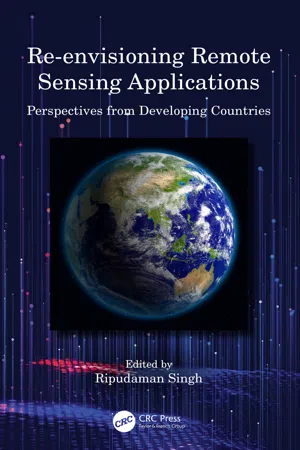
Re-envisioning Remote Sensing Applications
Perspectives from Developing Countries
- 329 pages
- English
- ePUB (mobile friendly)
- Available on iOS & Android
About this book
Re-envisioning Remote Sensing Applications: Perspectives from Developing Countries aims at discussing varied applications of remote sensing, with respect to upcoming technologies with diverse themes. Organized into four sections of overlapping areas of research, the book covers chapters with themes related to agriculture, soil and land degradation studies; hydrology, microclimates and climate change impacts; land use/land cover analysis applications; resource analysis and bibliometric studies, culminating with future research agenda. All the topics are supported via case studies and spatial data analysis.
Features:
- Provides the applications of remote sensing in all fields through varied case studies and spatial data analysis
- Includes soil and land degradation, microclimates, and climate change impacts
- Covers remote sensing applications in broad areas of agriculture, hydrology, land use/land cover change and resource analysis
- Discusses usage of GPS-enabled smartphones and digital gadgets used for mapping and spatial analysis
- Explores future research agenda for applications of remote sensing in post-COVID scenario
This book is of interest to researchers and graduate students in environmental sciences, remote sensing, GIS, agricultural scientists and managers, forestry scientists and managers, and water resources scientists and managers.
Frequently asked questions
- Essential is ideal for learners and professionals who enjoy exploring a wide range of subjects. Access the Essential Library with 800,000+ trusted titles and best-sellers across business, personal growth, and the humanities. Includes unlimited reading time and Standard Read Aloud voice.
- Complete: Perfect for advanced learners and researchers needing full, unrestricted access. Unlock 1.4M+ books across hundreds of subjects, including academic and specialized titles. The Complete Plan also includes advanced features like Premium Read Aloud and Research Assistant.
Please note we cannot support devices running on iOS 13 and Android 7 or earlier. Learn more about using the app.
Information
Section III
Land Use/Land Cover Analysis Applications
9 Rural Land Transformation in Chandigarh Periphery
9.1 Introduction
Table of contents
- Cover
- Half-Title
- Title
- Copyright
- Contents
- Preface
- Acknowledgments
- Editor
- Contributors
- Prologue: Re-envisioning Remote-Sensing Applications
- SECTION I Agricultural, Soil and Land Degradation Studies
- SECTION II Hydrology, Microclimates and Climate Change Impacts
- SECTION III Land Use/Land Cover Analysis Applications
- SECTION IV Resource Analysis and Bibliometric Studies
- Epilogue: Future Research Agenda
- Index